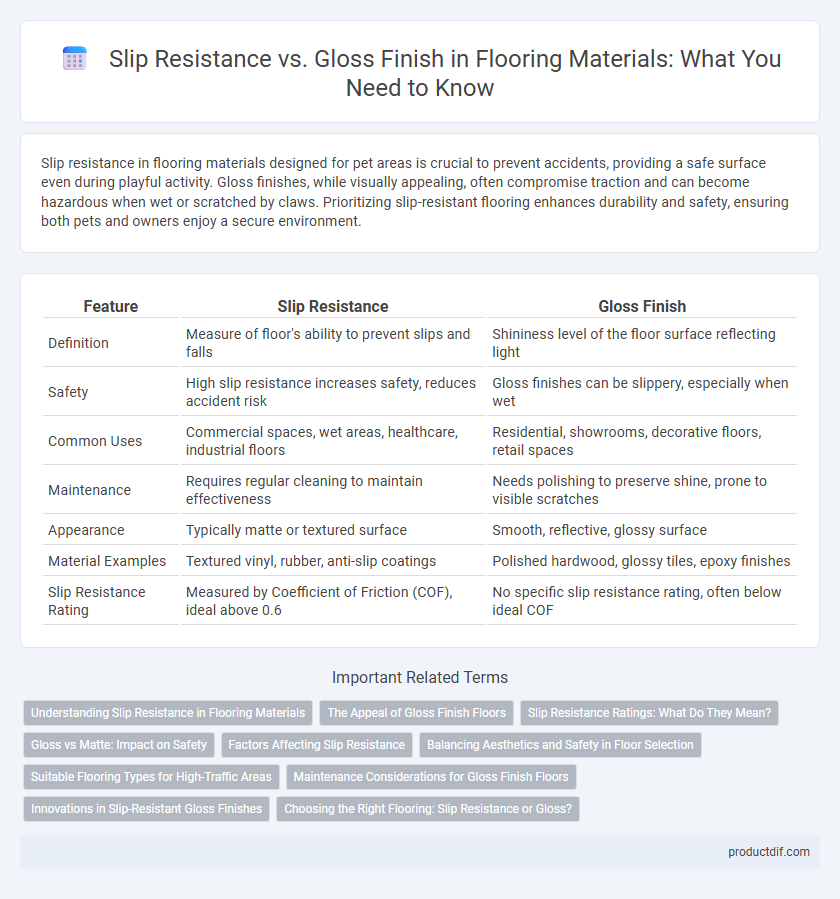Slip resistance in flooring materials designed for pet areas is crucial to prevent accidents, providing a safe surface even during playful activity. Gloss finishes, while visually appealing, often compromise traction and can become hazardous when wet or scratched by claws. Prioritizing slip-resistant flooring enhances durability and safety, ensuring both pets and owners enjoy a secure environment.
Table of Comparison
| Feature | Slip Resistance | Gloss Finish |
|---|---|---|
| Definition | Measure of floor's ability to prevent slips and falls | Shininess level of the floor surface reflecting light |
| Safety | High slip resistance increases safety, reduces accident risk | Gloss finishes can be slippery, especially when wet |
| Common Uses | Commercial spaces, wet areas, healthcare, industrial floors | Residential, showrooms, decorative floors, retail spaces |
| Maintenance | Requires regular cleaning to maintain effectiveness | Needs polishing to preserve shine, prone to visible scratches |
| Appearance | Typically matte or textured surface | Smooth, reflective, glossy surface |
| Material Examples | Textured vinyl, rubber, anti-slip coatings | Polished hardwood, glossy tiles, epoxy finishes |
| Slip Resistance Rating | Measured by Coefficient of Friction (COF), ideal above 0.6 | No specific slip resistance rating, often below ideal COF |
Understanding Slip Resistance in Flooring Materials
Slip resistance in flooring materials is a critical factor for safety, especially in high-traffic or wet areas like commercial kitchens and healthcare facilities. It is measured by coefficients of friction (COF), with values above 0.6 generally considered safe for walking surfaces to prevent slipping accidents. Gloss finish flooring often compromises slip resistance, as smoother, shinier surfaces tend to have lower COF, increasing the risk unless treated with non-slip coatings or textured finishes.
The Appeal of Gloss Finish Floors
Gloss finish floors enhance interior aesthetics by creating a sleek, reflective surface that amplifies natural and artificial lighting. This high-shine appearance elevates the perceived value and modernity of spaces, making them highly desirable in commercial and residential settings. Despite their visual appeal, it's crucial to balance gloss with appropriate slip resistance to ensure safety without compromising style.
Slip Resistance Ratings: What Do They Mean?
Slip resistance ratings measure the floor's ability to prevent slipping, crucial for safety in both residential and commercial spaces. These ratings, such as the Coefficient of Friction (COF) or Pendulum Test Values (PTV), quantify the traction level, helping to select flooring materials that minimize accident risks. Floors with higher slip resistance ratings provide enhanced grip, especially in wet or oily conditions, making them ideal for areas prone to spills and heavy foot traffic.
Gloss vs Matte: Impact on Safety
Gloss finish flooring reflects more light, increasing surface shine but often resulting in reduced slip resistance, particularly when wet or oily. Matte flooring absorbs light, providing better traction and minimizing the risk of slips and falls in high-traffic or moisture-prone areas. Selecting matte finishes for commercial and residential spaces significantly enhances safety by maintaining consistent grip without compromising aesthetic appeal.
Factors Affecting Slip Resistance
Slip resistance in flooring materials is primarily influenced by surface texture, coating type, and maintenance practices. Gloss finish floors often have smoother surfaces that can reduce friction, increasing the risk of slips, especially when wet or contaminated. Factors like the presence of anti-slip additives, surface roughness, and regular cleaning significantly enhance slip resistance without compromising the aesthetic appeal of glossy finishes.
Balancing Aesthetics and Safety in Floor Selection
Slip resistance and gloss finish are critical factors in flooring material selection, directly impacting safety and visual appeal. High gloss finishes, while enhancing aesthetics with their reflective properties, often reduce traction and increase the risk of slips, especially in wet environments. Balancing these requires choosing flooring options with certified slip resistance ratings, such as R10 or above, that maintain shine without compromising safety standards.
Suitable Flooring Types for High-Traffic Areas
Slip resistance is crucial for flooring materials in high-traffic areas, with options like textured vinyl, rubber, and matte-finished ceramic tiles providing optimal safety. Gloss finishes, commonly found in polished marble or high-gloss laminate, offer aesthetic appeal but often compromise traction and increase slip hazards. For commercial environments and busy public spaces, flooring types prioritizing slip resistance without sacrificing durability, such as slip-resistant epoxy coatings and anti-slip porcelain tiles, are the best choices.
Maintenance Considerations for Gloss Finish Floors
Gloss finish floors require regular cleaning with non-abrasive, pH-neutral cleaners to maintain their shine and slip resistance. High-gloss surfaces can show scratches and scuffs more easily, necessitating periodic polishing or refinishing to preserve their smooth finish. Proper maintenance ensures safety by reducing slip hazards while enhancing the floor's reflective appeal.
Innovations in Slip-Resistant Gloss Finishes
Innovations in slip-resistant gloss finishes combine advanced nanotechnology with textured surface coatings to enhance grip without compromising aesthetic appeal. Materials like polyurethane blends and silica-infused varnishes provide durable, high-gloss floors that meet rigorous safety standards for commercial and residential applications. These developments improve traction under wet or oily conditions, reducing slip-related accidents while maintaining the sleek, polished look favored in modern interior design.
Choosing the Right Flooring: Slip Resistance or Gloss?
Slip resistance is crucial for preventing accidents in high-traffic or moisture-prone areas, making materials like textured vinyl or matte-finish tiles ideal for safety. Gloss finish floors, such as polished hardwood or high-gloss epoxy, offer aesthetic appeal and light reflection but can be more slippery when wet. Selecting the right flooring requires balancing slip resistance needs with desired gloss levels, considering the specific environment and user safety priorities.
Slip Resistance vs Gloss Finish Infographic

 productdif.com
productdif.com